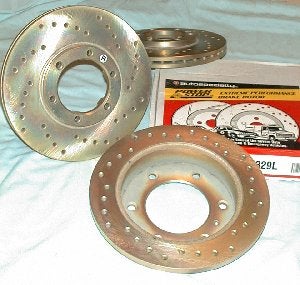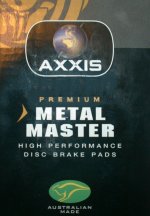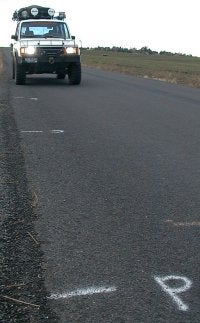Reviewer's Notebook: Autospecialty Power Stop Rotors & Metal Master Pads
 Autospecialty's Power
Stop extreme performance brake rotors are CNC-machined, double
disc-ground, and cross-drilled. Radiused holes in a directionally
drilled pattern enhance brake performance and almost eliminate brake
fade.
Autospecialty's Power
Stop extreme performance brake rotors are CNC-machined, double
disc-ground, and cross-drilled. Radiused holes in a directionally
drilled pattern enhance brake performance and almost eliminate brake
fade. |
Project WomBAT suffered all of these reductions in braking efficiency. The final blow was the addition of big rubber: Bridgestone's new Dueler MTs. The stock brakes were no longer up to the task, so we scoured the market for performance rotors and friction material (brake pads).
Autospecialty is a leader in the aftermarket brake modification field, and they produce applications for most every foreign and domestic 4x4, as well as automobiles. They offer Power Stop extreme performance brake rotors, as well as multiple friction material options, including 911 Extreme Performance pads and shoes.
 Detail of Autospecialty's
Power Stop extreme performance brake rotors. Vented and drilled, these
rotors really keep their cool.
Detail of Autospecialty's
Power Stop extreme performance brake rotors. Vented and drilled, these
rotors really keep their cool. |
 Autospecialty's Metal
Master brake pads, reknowned for their performance, hauled Project
WomBAT down to speed quickly and effectively with minimal fading.
Autospecialty's Metal
Master brake pads, reknowned for their performance, hauled Project
WomBAT down to speed quickly and effectively with minimal fading. |
Cross-drilling also improves rotor cooling, again defeating brake fade. On cross-drilled rotors, temperatures can be reduced by as much as 200 degrees during extreme braking when compared to stock rotors. Since braking is essentially the absorption of a moving vehicle's kinetic energy and conversion into heat, rotors that quickly and efficiently dissipate heat perform better. Cross-drilled rotors increase rate of heat dissipation by increasing surface area, allowing gases to escape, and increasing air flow.
The Metal Master brake pads we chose for the front calipers are well known for their performance characteristics. Metal Master pads were the best friction material available for the WomBAT, an '89 Isuzu Trooper, but other vehicles can use Autospeciality's 911 pads for an even higher coefficient friction. These pads have a great reputation, especially among the autocross crowd.
Because nearly three quarters of all braking is handled by front brakes, we opted for another Axxis (formerly Repco) product, their Metal-Lux semi-metallic pads, for the rear.
 Project
WomBAT's rear axle, with Autospecialty's Metal Master brake pads and
Power Stop extreme performance brake rotors installed.
Project
WomBAT's rear axle, with Autospecialty's Metal Master brake pads and
Power Stop extreme performance brake rotors installed. |
Installation
Bruneel Tire & Auto of Moscow, Idaho installed the new brake parts. Neither the pads nor the rotors required any unusual steps for installation.In addition to shorter breaking distances and diminished brake fade, we sought improved brake feel. That's why we simultaneously installed the extended braided stainless steel front brake lines that came with our CALMINI three inch lift kit. We also replaced the brake fluid with new DOT-approved fluid. When we complete the CALMINI lift, we won't have to bleed the brakes again.
Driving Performance
After driving gently for Autospeciality's recommended initial break-in period, we stomped on the brakes and improved stopping power was readily apparent. Instead of the smooth and drawn out stop we'd grown accustomed to, the WomBAT hauled down quickly, nose diving from deceleration. This same arresting performance continued without change through several thousand miles of mixed driving tests.Our only negative experience with these brakes occurred when the brakes were cold. Metal Master pads need to heat up a bit before they really "bite." As such, that first stop light of the morning can elevate the blood pressure a bit. Gently riding the pedal for a moment quickly reestablished the brake pads' grippiness.
On the trail, this brake combo is equally impressive as it is on the street. Braking sensitivity improved (no doubt, due partly to the improved brake lines) and the brakes lock up less easily on steep trails --- we don't have to mash the brake pedal to slow down anymore. In hot weather, the Power Stop rotors' improved cooling allows more constant braking quality with less fade, so less attention can be paid to braking as a whole. Contaminating the rotors with mud and water had no effect on braking, although we have not yet tested them in mud thick enough to clog the rotor's cross-drilled holes. Others who use cross-drilled rotors report that thick and sloppy conditions can plug the holes and require tedious cleaning with a screwdriver. The brakes would still work with the holes clogged, but the advantage of cross-drilling will be gone until the holes are cleaned.
The reduction in stopping distance was remarkable, but the most dramatic effect was the utter lack of fade. Descending mountain passes in the 5000+ lb WomBAT and nearly a ton of trailer no longer produces any appreciable brake fade. With the stock brakes, these descents were nerve-wracking and often required downshifting and selecting lower transmission gears just to "save" and assist the brakes. The margin of safety is noticeably wider, and we no longer need to remain alert to brake temperatures.
| 60-0 mph | 60-0 mph | 70-0 mph | |||
| 1998 Isuzu Amigo | 125' | 1998 Toyota 4Runner | 136' | 1998 Toyota 4Runner | 197' |
| 1998 Jeep G/Cherokee | 126' | 1998 Ford Explorer | 138' | 1998 Isuzu Rodeo | 206' |
| 1998 Mercury Mountaineer | 127' | 1998 Oldsmobile Bravado | 141' | 1998 Isuzu Rodeo | 216' |
| 1998 Toyota RAV4 | 132' | 1998 Isuzu Rodeo | 146' | ||
| 1998 Nissan Pathfinder | 134' | 1980 Toyota FJ40 | 226' | ||
| 1998 Subaru Outback | 134' | ||||
| Despite the WomBAT's weight, the truck compares favorably with other SUVs' braking distances. Stock four wheel disk brakes offset the Trooper's 3700lbs curb weight. For comparison, examine these braking distances cited in a recent issue of Road & Track magazine. | |||||
Brake Testing
 Project
WomBAT stops on the test road.
Project
WomBAT stops on the test road. |
We started braking on each run at the same marker, and depressed the brake pedal forcefully. We started in fourth gear, and pressed the clutch about halfway through deceleration. When the truck was fully stopped, we measured the distance between the marker and the truck's front axle. Immediately afterwards, we'd repeat the test after accelerating for another half mile down the road.
| TestSet 1 | TestSet 2 | TestSet 3 | TestSet 4 | TestSet 5 | |||||
| 1.1 | 133'* | 2.1 | 169' | 3.1 | 123' | 4.1 | 129' | 5.1 | 162' |
| 1.2 | 150'* | 2.2 | 144' | 3.2 | 117' | 4.2 | 128' | 5.2 | 146' |
| 1.3 | 162' | 2.3 | 146' | 3.3 | 131' | 4.3 | 154' | 5.3 | 139' |
| 1.4 | 173' | 2.4 | 146' | 3.4 | 137' | 4.4 | 148' | 5.4 | 138' |
| 1.5 | 184' | 2.5 | 155' | 3.5 | 129' | 4.5 | 146' | 5.5 | 149' |
| 2.6 | 176' | 3.6 | 133' | 4.6 | 156' | ||||
| 2.7 | 195' | 3.7 | 147' | 4.7 | 137' | ||||
| 3.8 | 154' | ||||||||
Despite the disparity in ambient and roadway temperatures between sets, the Power Stop/Metal Master provides obviously better braking than the stock setup. Once heated up, the stock brakes quickly faded, lengthening braking distances by 10 to 20 feet each subsequent stop.
The same vehicle with the new brake components stopped significantly faster, and displayed little brake fade -- carrying a larger payload and working against a tailwind. We could lock up all four tires, something that's pretty hard to do with the stock Trooper brakes. Using a lighter foot yielded some of the longer distances, (3.7 and 3.8) but the distances came back down as we developed a feel for the skid threshold.
| Set Number | Conditions and Notes |
| TestSet 1 | All stock brake components 6:00pm, sunny, 85 degrees, dry, no wind 60lb on roof, 4700 lb GVW * Started in third gear, rather than fourth |
| TestSet 2 | All stock brake components 8:30am, sunny, 60 degrees, dry, no wind 60lb on roof, 4800 lb GVW |
| TestSet 3 | Power Stop rotors and Metal Master pads 2:30pm, partly cloudy, 40 degrees, dry, 10-15mph tailwind 150lb on roof, 5000 lb GVW |
| TestSet 4 | Power Stop rotors and Metal Master pads 8:30am, overcast, 34 degrees, drizzle, 10mph headwind 300lb on roof, 5100 lb GVW |
| TestSet 5 | Power Stop rotors and Metal Master pads 9:00am, sunny, 40 degrees, dry, 15mph tailwind 300lb on roof, 5150 lb GVW |
When we ran tests with the 32" tires, the braking distances were amazingly similar to that with the stock tire size. We were still adjusting to the feel of the pedal and skid threshold, which explains the variation in the distances, but the Power Stop/Metal Master combo still managed to reel in the mass of the WomBAT. Heating up the brakes allowed even shorter braking distances in subsequent runs. The lack of disparity between distances for TestSets 3 and 4 is most likely explained by the net 20+ mph difference in wind speeds, which favored the testing with the 32s. Concerns about road moisture and skidding (which did not materialize) resulted in somewhat less aggressive braking and may explain some longer distances in TestSet 4. Conversely, the dry conditions in TestSet 5 allowed a better comparison with TestSet 3. Both took place during similarly strong tailwinds. Through all conditions the Bridgestones performed very well, showing no apparent change in traction as a light drizzle began to fall on run 4.3. This is a real testimonial to the stickiness of these tires -- the larger tire diameter should have really lengthened braking distances but it did not.
Conclusions
We experienced none of the mud plugging cross-drilled rotors of which we'd been warned. Such problems may exist, but our dry summer prevented us from testing this. Even if post-muddin' cleanup includes hole-by-hole cleanup, we'll do that work -- the brakes are THAT much better! Using Autospecialty 's performance brake products proved to be a real boon for Project WomBAT. We experienced a dramatic increase in braking power and an even more impressive reduction of brake fade. These improvements recaptured a margin of safety that had been lost to other modifications. Off-road and on-road driving is clearly safer and more confidence-inspiring.If your 4x4 evolved -- or may evolve -- into a beast that overwhelms the stock braking system, consider upgrading your pads and rotors. Chances are that Autospecialty can help with your application, as well.
800 E. 230th St., Suite ORC
Carson CA 90745
(800) 275-3617
Tell them that you saw the Project WomBAT article on Off-Road.com!


 Your Privacy Choices
Your Privacy Choices